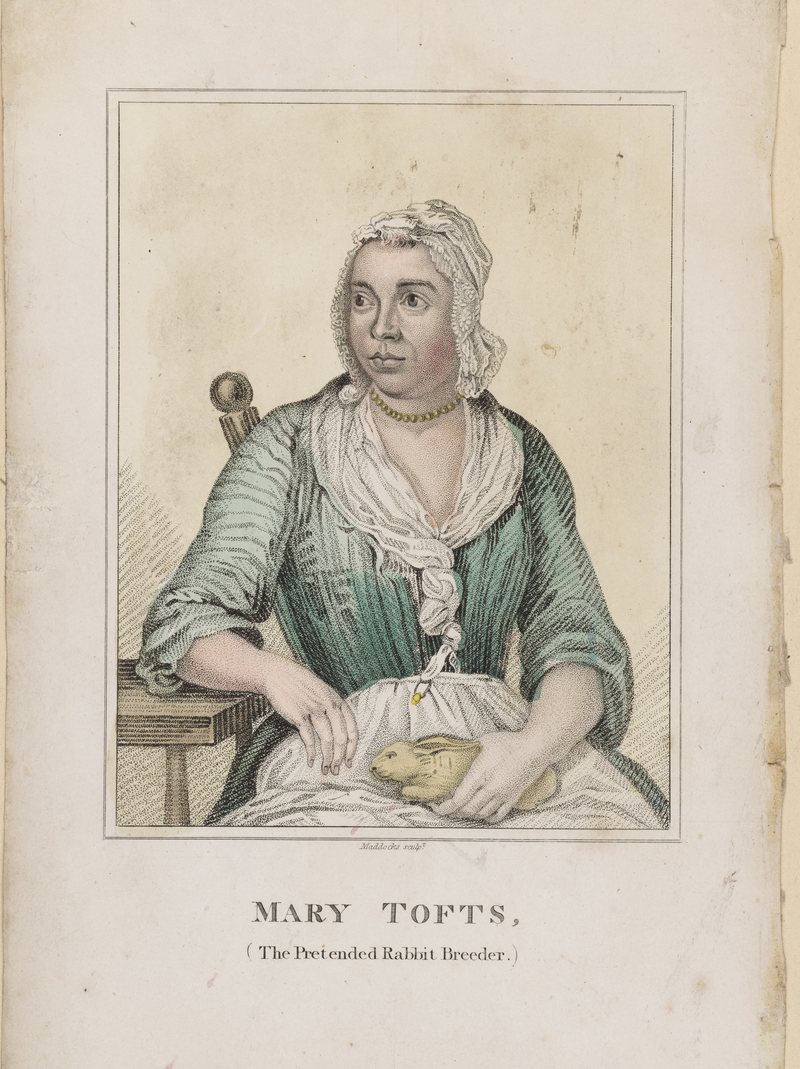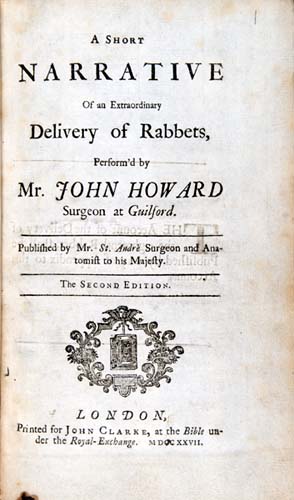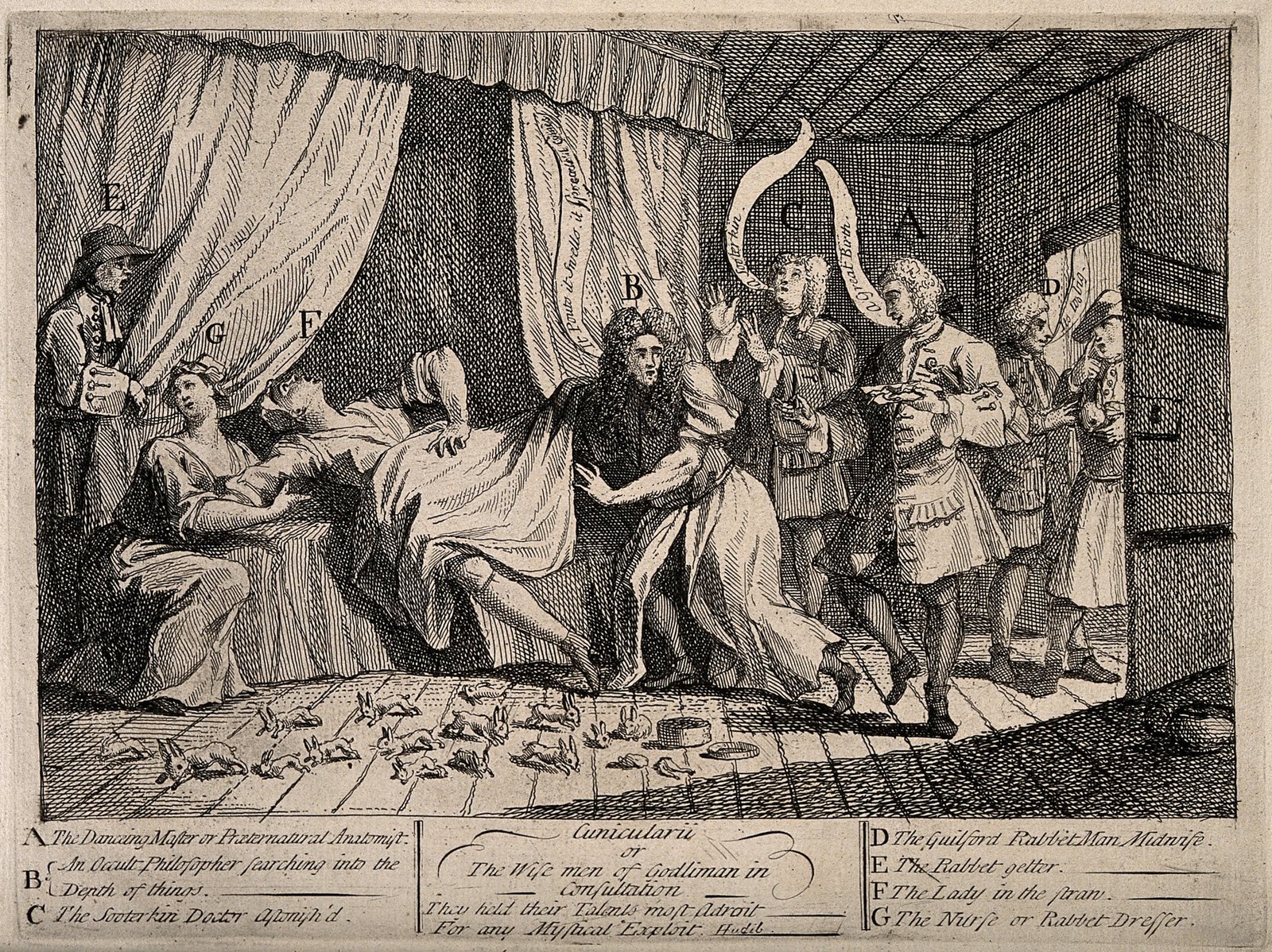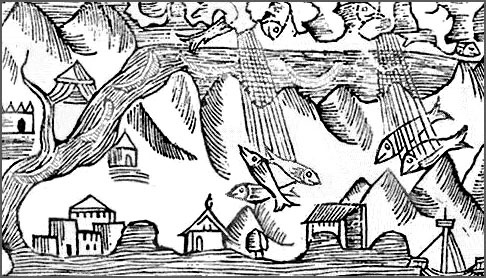CW: Miscarriage.
In 1726, when the rest of the country were dealing with periodic harvest failures and outbursts of influenza and smallpox, Mary Toft sat at home in Godalming, Surrey and gave birth to rabbits. Within months, she convinced countless doctors and even the King of the legitimacy of her litter, giving birth to bunnies 17 times.

In 1720, Mary married Joshua Toft and the couple had three healthy children together. However, in 1726, when Mary became pregnant again, all was not well.
Miscarriages were commonplace in the 18thcentury, not least because of a lack of healthcare and formal advice, but because many working class women were forced to continue their work – often hard labour – throughout their pregnancy.
Sadly, Mary miscarried her baby. Then aged 25, she gave birth to several clumps of viscera. These were of varying size, one which was said to be ‘as big as my arm’. This suggests that Mary’s pregnancy was simply not viable, as she developed severe abnormalities of the placenta.
However, what Mary saw in the miscarriage was far from human; she believed herself to have birthed several animal parts. A neighbour was called who examined the parts, baffled, and showed her family. They then passed under the scrutiny of local midwives who were dubious of their origin, but could offer no explanation. The pieces were lastly sent to local midwife John Howard, who had thirty years’ experience in the field. He initially dismissed Toft as foolish but visited her the next day, where she fell ill and went into labour once more. She then gave birth to several more animal parts, predominantly rabbit.

Mary’s family called upon a local surgeon, John Howard, who keenly investigated the matter.
Mary’s pregnancy plight was far from over as, upon Howard’s arrival, he assisted her in delivering more animal parts. According to the surgeon, he retrieved ‘three legs of a Cat of a Tabby Colour, and one leg of a Rabbet: the guts were as a Cat’s and in them were three pieces of the Back-Bone of an Eel. The cat’s feet supposed were formed in her imagination from a cat she was fond of that slept on the bed at night.” [1]This would suggest that Toft claimed that the births were as a result of some form of mental manifestation; her dreams becoming flesh in her womb.
John Maubray, a famous physician, was particularly pleased with Mary’s plight. In his work, The Female Physician, Maubray proposed that women could give birth to non-human children, which he named ‘sooterkin’. He believed in the power of ‘maternal impression’, in that sooterkin came about through the dreams and thoughts of the expectant mother. He subsequently warned women not to become too fond of, or over-familiar with, household pets during pregnancy, lest their children resemble those pets. Through Mary’s animal births, for a short period, Maubray’s theory was somewhat vindicated.
As reported in Mists Weekly Journal, 19thNovember 1726,
From Guildford comes a strange but well-attested Piece of News. That a poor Woman who lives at Godalmin [sic], near that Town, was about a Month past delivered by Mr John Howard, an Eminent Surgeon and Man-Midwife, of a creature resembling a Rabbit but whose Heart and Lungs grew without [outside] its Belly, about 14 Days since she was delivered by the same Person, of a perfect Rabbit: and in a few Days after of 4 more; and on Friday, Saturday, Sunday, the 4th, 5th, and 6th instant, of one in each day: in all nine, they died all in bringing into the World. The woman hath made Oath, that two Months ago, being working in a Field with other Women, they put up a Rabbit, who running from them, they pursued it, but to no Purpose: This created in her such a Longing to it, that she (being with Child) was taken ill and miscarried, and from that Time she hath not been able to avoid thinking of Rabbits. People after all, differ much in their Opinion about this Matter, some looking upon them as great Curiosities, fit to be presented to the Royal Society, etc. others are angry at the Account, and say, that if it be a Fact, a Veil should be drawn over it, as an Imperfection in human Nature.

However, for Mary, her experiences in hellish maternity had just begun. Shortly thereafter, Mary gave birth to nine dead baby rabbits. The visiting surgeon soon made sure to notify other prominent physicians including Nathanial St. André, personal surgeon to the house of King George I.
St. André and Howard exchanged several letters recounting the experiences, some of which were bound into St. André’s pamphlet, ‘A short narrative of an extraordinary delivery of rabbets’ (1727)

Sir,
Since I wrote to you, I have taken or deliver’d the poor Woman of three more Rabbets, all three half grown, one of them a dunn Rabbet; the last leap’d twenty three Hours in the Uterus before it dy’d. As soon as the eleventh Rabbet was taken away, up leap’d the twelfth Rabbet, which is now leaping. If you have any curious Person that is pleased to come Post, may see another leap in her Uterus, and shall take it from her if he pleases; which will be a great Satisfaction to the Curious: If she had been with Child, she has but ten Days more to go, so I do not know how many Rabbets may be behind; I have brought the Woman to Guildford for better Convenience.
I am, Sir, Your humble Servant,
John Howard.[13]
St. André later details how he examined one of the resulting rabbits. To test if the rabbit had developed fully and had functioning lungs, he placed a piece of its lung in water to see if it would float, which it duly did. After examining Toft once more, the doctor deduced that the rabbits had been bread in her fallopian tubes and the peasant woman had most certainly not been inserting carcasses into herself.

By this point, Toft had made quite a name for herself with her insane births and London’s great and good were clamouring for news of her latest feats.
The political writer John Hervey later wrote to his friend Henry Fox, saying:
Every creature in town, both men and women, have been to see and feel her: the perpetual emotions, noises and rumblings in her Belly are something prodigious; all the eminent physicians, surgeons and man-midwives in London are there Day and Night to watch her next production.
Under the watch of the king, St. André keenly studied Toft and professed her uterine plight to be legitimate. However, unsure of St. André’s judgement, he also sent fellow surgeon, Cyriacus Ahlers, to investigate the rabbit-birthing woman of Surrey.

When brought to London and thoroughly examined, Toft failed to birth any more animals, despite going into labour several times. On the 4thDecember, Toft’s miraculous births were exposed. Thomas Onslow was one of many others investigating Toft’s claims, but the first to look beyond the medical. Onslow dug a little deeper into Mary’s family and saw that her husband had recently been buying a lot of young rabbits. Believing he had enough evidence to expose the fraud, he wrote to a colleague, saying he would soon publish his findings. However, the same day, a porter confessed to being bribed by Mary’s sister-in-law to smuggle a rabbit into Toft’s room.
Under interrogation, Mary held fast in her story, completely denying the accusation. Her sister-in-law was not so steadfast and confessed to smuggling the rabbit, albeit only for food.
After days of prolonged questioning, Manningham, another surgeon, said he believed that something remained in Toft’s uterus and that a painful operation would be necessary. On the 7thDecember, surrounded by investigating surgeons, Toft confessed. It had all been a hoax.
Toft had indeed had a miscarriage, yet while her cervix was still dilated, the feet and body of a cat and the head of a rabbit had been inserted within her. For all later births, smaller animal parts had simply been inserted into her vagina. Together, they had also concocted a story that while working in a field, Mary had become startled by a rabbit which began an obsession that lasted throughout her pregnancy.
Her confessions were extensive and inconsistent, blaming family and midwives alike. Most interestingly, she claimed that a travelling woman had told her how to insert rabbits into her body and that the trick would ensure wealth.

The shockwaves from her exposure rippled across the country for months to come. Toft may have been a laughing stock, but the medical professionals who believed her deception were subjected to intense public mockery. Many careers were thoroughly tarnished and satirists were provided with material for months. Famously, artist and social critic William Hogarth created an etching titled, ‘Cuniculrii’ (combining the latin words for ‘rabbit’ and ‘vulva’) or ‘Credulity, superstition and fanaticism’, whereby London doctors are seen tending to Toft in labour as baby rabbits scamper across the floor.
On 7thJanuary 1727, Mary appeared at the Courts of Quarter Sessions and Westminster, charged ‘for being an abominable cheat and imposter in pretending to be delivered of several monstrous births.’ Despite all that faced her, she remained silent throughout and refused to further comment during her trial.
After spending four months in jail, in a public-facing cell, Toft was eventually released without charge and returned home to Surrey. Back in Godalming, she lived a life of relative obscurity before dying at the age of 60 in 1763.
Upon her death, the parish recorded her as, ‘Mary Toft, Widow, The Impostress Rabbitt.’

*
Sources / Further Reading:
https://www.gla.ac.uk/myglasgow/library/files/special/exhibns/month/aug2009.html
https://www.theparisreview.org/blog/2016/07/05/an-extraordinary-delivery-of-rabbits/
https://www.atlasobscura.com/articles/mary-toft-gave-birth-to-rabbits
[1]From Hogarth to Rowlandson: Medicine in Art in Eighteenth-Century Britain. Fiona Haslam.






Leave a comment